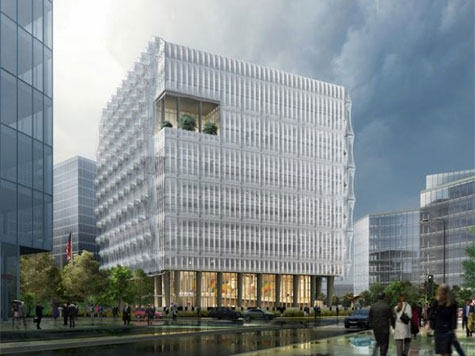Under the Obama administration, embassy construction costs have exploded even while security – a major issue in the Benghazi scandal – has grown worse.
Now we know why.
A video released by the State Department in 2012 shows exhibits the philosophy behind a campaign begun under former Secretary of State Hillary Clinton to build fancy buildings overseas to enhance the nation’s reputation.
The video opens with a narrator explaining the “universally understood language of diplomacy” including “art, design and architecture” that “communicate our ideals…without speaking a word.”
From there, a series of high-profile architects use embarrassingly flowery language to explain how excited they are that the U.S. government is funding their dream job.
“It’s an incredibly complicated conversation. It’s lyrical, poetic. Because it’s about the human being, and it’s about who we are as human beings,” says Thom Mayne, the 2005 winner of the Pritzker Architecture Prize.
The video is designed to sell the State Department’s “Design Excellence” program which replaced building designs standardized under the George W. Bush administration that were crafted for efficiency.
Aesthetics can have a steep price tag, it turns out.
Rep. Jason Chaffetz (R-UT), a key member of the House Oversight and Government Reform Committee, says the program has gone way too far.
An embassy rebuild in Papa New Guniea, he said, was expected to cost $50 million, but under the new program the price has ballooned to over $200 million. The project also faces significant delays.
“They believe that architecture is diplomacy, which to me is somewhat laughable. It puts people in harm’s way,” Chaffetz says.
When Chaffetz briefly visited the Papa New Guniea embassy site to investigate, there was an attempted carjacking of an embassy staffer, underscoring that security threats to these facilities are considerable.
In the eight minute video, the architects only reach the subject of security around half-way through – and describe it more as a nuisance that has to be “designed around.”
“They’re really trying to make buildings feel as if they are related to the country where they’re placed, so that they don’t feel as if they’re something that’s simply imported nor do they feel as if they’re totally fortified,” Billie Tsien says.
The way to design around security is landscape, adds Tod Williams.
“You would be generous with your landscape and generous with the hand that you reach out to the community. And within that we find different ways that we can disguise the lines of security that are so crucial,” he says.
In June, CBS News reported that a new embassy in London, a modern glass structure nicknamed “the cube,” is running over $100 million over its $1 billion budget.
Tomorrow, the oversight panel is holding a hearing on the subject. Chaffetz and Chairman Darrell Issa this week sent a request for detailed information from the State Department about who approved the new direction and flagged projects all over the world for additional scrutiny.
The issue of embassy security is getting a closer look following the Benghazi scandal, in which requests for additional security were rebuffed. A terrorist attack on September 11, 2012 left four Americans, including the ambassador, dead.

COMMENTS
Please let us know if you're having issues with commenting.